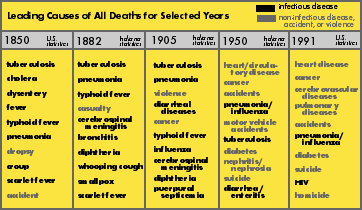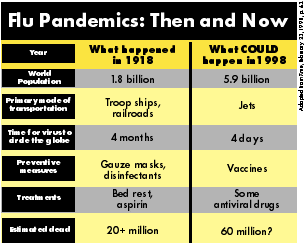Life free from disease is an advantage that many people in the United States take for granted. Most people have confidence that food, water, and medicines are safe, and that waste products and garbage are disposed of properly. Local, state, and federal laws exist to protect citizens from food and drug adulteration and water pollution and to require immunization against certain contagious diseases. Extraordinary health challenges remain, but scientists now have sophisticated tools and knowledge to fight diseases and health hazards that occur.
In the seventeenth, eighteenth, and nineteenth centuries, the situation was very different. Diseases of the earliest colonists in North America included smallpox, malaria, diarrheas and dysenteries, respiratory problems, measles, mumps, scarlet fever, diphtheria, and others (Duffy, 10). Typhoid, yellow fever, and cholera also killed many people.
Until the last half of the nineteenth century, doctors knew almost nothing about the real causes of diseases. Bleeding, purging, vomiting, and blistering were standard treatments for many illnesses (Ibid., 20). There were many dangerous patent medicines, including compounds such as calomel containing mercury which is poisonous (Janssen, 17).
As the population grew before and after the American Revolution, the number of people affected with diseases also increased. People knew that many diseases were contagious. Doctors did not know how diseases were spread. One popular theory was the "miasma" theory, which stated that disease was caused by the gaseous substances coming from stagnant water or decaying matter (Duffy, 24, 21-22, 41). Doctors and local officials could find many areas that fit the "miasma" theory.

This chart documents causes of death over time. In the later years most leading causes of death are no longer from infectious diseases. These statistics demonstrate the effect of advances in science and medicine. Statistics for 1850 and 1991 are for the United States.

This chart demonstrates the dramatic reduction of early childhood deaths in Indiana related to all people who died in Indiana (Indiana statistics).
During the first half of the nineteenth century, street cleaning and garbage removal was the responsibility of individual citizens. In addition, hogs, cattle, and horses were allowed to roam the streets in cities and towns. Another major problem was the disposal of human waste. Some larger cities employed people to empty privies, but most small towns had no such provisions. Drainage from overflowing privies and accumulating garbage often contaminated community water supplies (Ibid., 69, 71, 73, 75).
Rapidly growing population, new technology, and increased manufacturing in America's cities in the nineteenth century brought additional health problems. In small towns, citizens safely grew and produced most of their own food. In larger cities, milk, meat, and canned foods were generally supplied to people by dairies, meat packers, and food processors. As early as the seventeenth century, New York and Massachusetts had laws regulating specific foods (Young, 33-34). Massachusetts, in 1785, passed what "is generally considered the first comprehensive food adulteration law . . . in the United States" (Janssen, 17).

This chart demonstrates how the flu--an infectious disease--spread in 1918 and how it COULD spread in 1998. The short time today for a disease to spread globally presents major challenges for public health scientists. What is a pandemic? What other pandemics have there been in history? Are there any pandemics today?
American pharmacists and physicians were also concerned about the purity of drugs and medicines. This concern helped establish the first two schools of pharmacy in the U.S.--in Philadelphia in 1820 and in New York City in 1828. By the 1840s, there was enough concern about drug adulteration that the U.S. Congress passed the Drug Importation Act of 1848. This law required all drugs entering the U.S. through its six major ports to be analyzed for "quality, purity, and fitness for medical purposes" (Young, 7, 6, 10, 14).
Throughout the rest of the nineteenth century, more states passed pure food and drug legislation. The Pure Food and Drugs Act of 1906 was the beginning of federal regulation of food and drugs in the U.S. (Young, 3).
During this same period, public health evolved as a medical discipline and a governmental function. Reviewing public health in Indiana in 1916, Dr. William F. King, assistant state health commissioner, provided his definition of the field of public health:
Public health is synonymous with preventive medicine, and preventive medicine had its real beginning with the discoveries of Pasteur . . . . Pasteur proved that so-called contagious diseases were due to germs . . . and he said, "It is within the power of man to drive all contagious and infectious diseases from the earth" (King, 272).
The life expectancy of a male infant at birth in Massachusetts or New Hampshire in 1789--just a few years after the American Revolution--was 34.5 years (Cummings, [238]). The life expectancy of a white male born in 1990 was 72.9 years (Statistical Abstracts of the U.S.). The dramatic increase in life expectancy can be traced to the efforts of scientists in private businesses and government agencies to protect and improve the public health of American citizens (Duffy, 134, 148-49).
